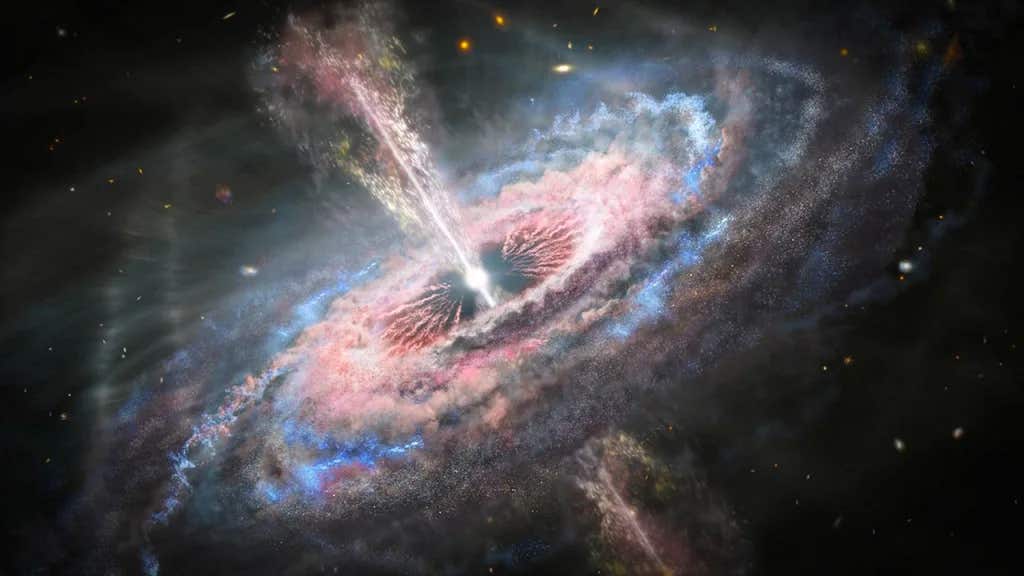NASA’s Hubble Telescope Reveals Secrets of a Monster Black Hole
NASA’s Hubble has captured its sharpest look yet at quasar 3C 273, revealing strange shapes and a massive jet near a monster black hole.

NASA’s Hubble captures a never-before-seen close view of quasar 3C 273, unlocking secrets of black holes and galaxy evolution. (CREDIT: NASA, ESA and J. Olmsted)
Astronomers have reached deeper into the heart of a brilliant cosmic engine than ever before, using NASA’s Hubble Space Telescope to capture a rare, close-up view of a quasar’s core. Quasars are some of the brightest and most powerful objects in the universe. They sit at the centers of galaxies and shine as black holes devour nearby matter, releasing energy that outshines entire galaxies.
The telescope targeted one of the first and most famous quasars ever discovered: 3C 273. This glowing galactic core sits more than 2.5 billion light-years from Earth and was first identified in 1963. For decades, 3C 273 has helped scientists explore how black holes grow and interact with the galaxies around them. Now, with the help of a powerful instrument aboard Hubble, scientists have seen 3C 273 with more clarity than ever before.
A Closer Look at a Cosmic Powerhouse
To understand how special this view is, consider the challenge faced by the Hubble team. Studying a quasar like 3C 273 is like staring into a car headlight and trying to see an ant walking on the edge of the lens. The glare is overwhelming, and it hides the fine details around the black hole.
But with the help of Hubble’s Space Telescope Imaging Spectrograph (STIS), astronomers have found a way around the glare. STIS acts like a coronagraph, a device that blocks out a central light source—much like how the Moon blocks the Sun during a solar eclipse. By dimming the quasar’s blinding core, astronomers could finally peer into its surrounding environment.
What they found surprised them.
"We've got a few blobs of different sizes, and a mysterious L-shaped filamentary structure," said Bin Ren of the Côte d'Azur Observatory and Université Côte d'Azur in France. “This is all within 16,000 light-years of the black hole.”
These strange features may be more than just cosmic debris. Some could be small satellite galaxies falling into 3C 273, feeding the supermassive black hole at the center. That process could be what fuels the quasar’s incredible energy. Ren added, “Thanks to Hubble's observing power, we're opening a new gateway into understanding quasars. My colleagues are excited because they've never seen this much detail before.”
Related Stories
Quasars: Ancient Beacons of Energy
Quasars were most common around 3 billion years after the Big Bang, a time when galaxy collisions were frequent. These massive mergers often sent huge amounts of matter spiraling toward central black holes, igniting them into bright quasars.
Despite being so far away, quasars like 3C 273 shine with astonishing power. This particular quasar is more than 10 times brighter than even the largest known galaxies. If it were located just tens of light-years from Earth, it would appear as bright as the Sun.
The key to this brilliance is the material falling into the black hole. As gas and dust spiral inward, they heat up and release energy across the electromagnetic spectrum—from radio waves to visible light and even X-rays. That process makes quasars some of the most luminous objects in space.
Yet, for all their brightness, most quasars still look like small dots from Earth. Their structure and the galaxies that host them have remained mysterious—until now.
Revealing the Hidden Host Galaxy
Before Hubble’s sharper vision in the 1990s, many scientists believed quasars were simple. But early Hubble images quickly challenged that view. They revealed signs of galactic collisions, swirling dust, and chaos in the space around these black holes. Over time, it became clear that quasars weren’t just isolated beacons—they were deeply connected to their host galaxies and the universe’s violent history.
In this latest study, scientists used the coronagraph in a way never attempted before for quasars. It let them see eight times closer to the black hole than ever before, pulling back the curtain on the region around 3C 273. With clearer images, researchers could examine the structure of the galaxy and the impact of the quasar’s energy.
Hubble’s detailed view also showed an enormous jet of material stretching 300,000 light-years into space. This jet, blasting out from the black hole’s poles at nearly the speed of light, is one of the most extreme features in astronomy.
By comparing new coronagraphic data with older Hubble images taken 22 years earlier, scientists tracked the jet’s movement. They found that parts of the jet seem to move faster the farther they get from the black hole. This strange behavior may be linked to how the jet interacts with the surrounding galaxy and intergalactic space.
“With the fine spatial structures and jet motion, Hubble bridged a gap between the small-scale radio interferometry and large-scale optical imaging observations,” Ren said. “We can now take an observational step toward a more complete understanding of quasar host morphology.”
A Tool for Future Exploration
Hubble’s ongoing mission has transformed how we understand the universe. It’s a joint project between NASA and the European Space Agency, with help from multiple research centers and institutions. Even after more than 30 years in space, Hubble continues to deliver discoveries that change science.
The detailed images of 3C 273 are another example of its power. Not only do they offer new insights into how black holes grow, but they also highlight the complex relationships between galaxies, mergers, and cosmic energy. At least one million quasars are known to exist across the sky, and each offers a new opportunity to understand the early universe.
These distant objects also serve as valuable tools. Because quasars are so bright, they can act like background flashlights, helping astronomers study the material between Earth and the distant object. This allows scientists to map the gas and dust that fills the universe, offering a better sense of its structure.
Looking ahead, astronomers hope to use the James Webb Space Telescope to study 3C 273 in infrared light. This could reveal even more about the dust and stars near the black hole. With new tools and new methods, the journey to understand quasars is just beginning.
Note: The article above provided above by The Brighter Side of News.
Like these kind of feel good stories? Get The Brighter Side of News' newsletter.
Mac Oliveau
Science & Technology Writer | AI and Robotics Reporter
Mac Oliveau is a Los Angeles–based science and technology journalist for The Brighter Side of News, an online publication focused on uplifting, transformative stories from around the globe. Passionate about spotlighting groundbreaking discoveries and innovations, Mac covers a broad spectrum of topics—from medical breakthroughs and artificial intelligence to green tech and archeology. With a talent for making complex science clear and compelling, they connect readers to the advancements shaping a brighter, more hopeful future.



